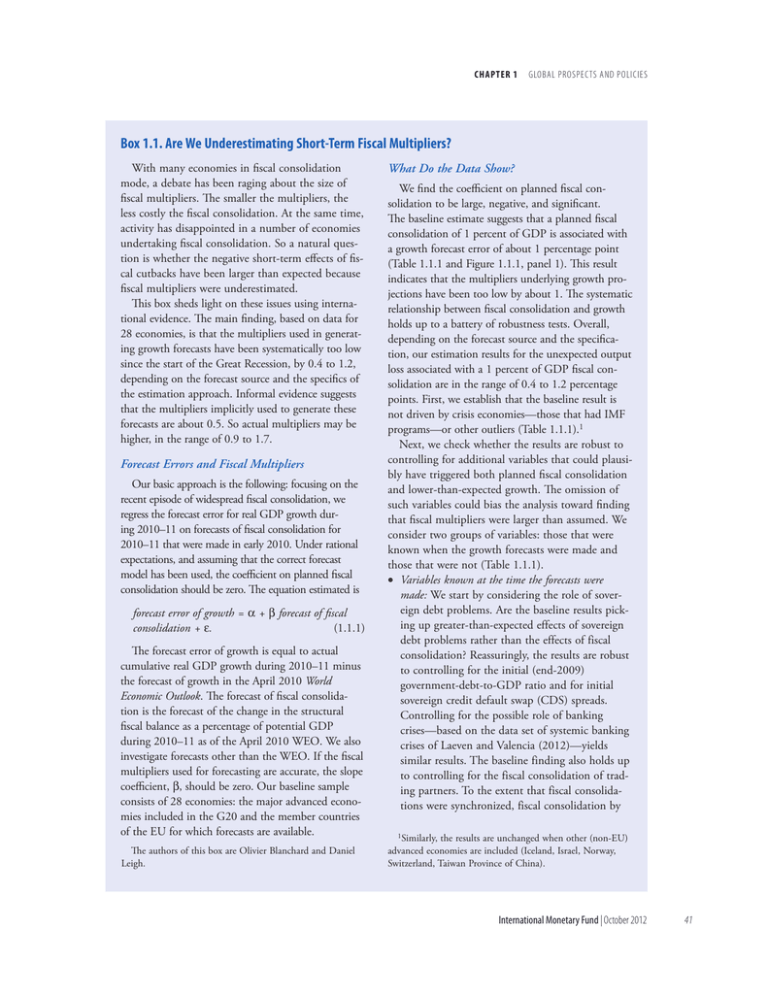What Do the Data Show?
advertisement

chapter 1 Global Prospects and Policies Box 1.1. Are We Underestimating Short-Term Fiscal Multipliers? With many economies in fiscal consolidation mode, a debate has been raging about the size of fiscal multipliers. The smaller the multipliers, the less costly the fiscal consolidation. At the same time, activity has disappointed in a number of economies undertaking fiscal consolidation. So a natural question is whether the negative short-term effects of fiscal cutbacks have been larger than expected because fiscal multipliers were underestimated. This box sheds light on these issues using international evidence. The main finding, based on data for 28 economies, is that the multipliers used in generating growth forecasts have been systematically too low since the start of the Great Recession, by 0.4 to 1.2, depending on the forecast source and the specifics of the estimation approach. Informal evidence suggests that the multipliers implicitly used to generate these forecasts are about 0.5. So actual multipliers may be higher, in the range of 0.9 to 1.7. Forecast Errors and Fiscal Multipliers Our basic approach is the following: focusing on the recent episode of widespread fiscal consolidation, we regress the forecast error for real GDP growth during 2010–11 on forecasts of fiscal consolidation for 2010–11 that were made in early 2010. Under rational expectations, and assuming that the correct forecast model has been used, the coefficient on planned fiscal consolidation should be zero. The equation estimated is forecast error of growth = α + β forecast of fiscal consolidation + ε. (1.1.1) The forecast error of growth is equal to actual cumulative real GDP growth during 2010–11 minus the forecast of growth in the April 2010 World Economic Outlook. The forecast of fiscal consolidation is the forecast of the change in the structural fiscal balance as a percentage of potential GDP during 2010–11 as of the April 2010 WEO. We also investigate forecasts other than the WEO. If the fiscal multipliers used for forecasting are accurate, the slope coefficient, β, should be zero. Our baseline sample consists of 28 economies: the major advanced economies included in the G20 and the member countries of the EU for which forecasts are available. The authors of this box are Olivier Blanchard and Daniel Leigh. What Do the Data Show? We find the coefficient on planned fiscal consolidation to be large, negative, and significant. The baseline estimate suggests that a planned fiscal consolidation of 1 percent of GDP is associated with a growth forecast error of about 1 percentage point (Table 1.1.1 and Figure 1.1.1, panel 1). This result indicates that the multipliers underlying growth projections have been too low by about 1. The systematic relationship between fiscal consolidation and growth holds up to a battery of robustness tests. Overall, depending on the forecast source and the specification, our estimation results for the unexpected output loss associated with a 1 percent of GDP fiscal consolidation are in the range of 0.4 to 1.2 percentage points. First, we establish that the baseline result is not driven by crisis economies––those that had IMF programs—or other outliers (Table 1.1.1).1 Next, we check whether the results are robust to controlling for additional variables that could plausibly have triggered both planned fiscal consolidation and lower-than-expected growth. The omission of such variables could bias the analysis toward finding that fiscal multipliers were larger than assumed. We consider two groups of variables: those that were known when the growth forecasts were made and those that were not (Table 1.1.1). •• Variables known at the time the forecasts were made: We start by considering the role of sover­ eign debt problems. Are the baseline results picking up greater-than-expected effects of sovereign debt problems rather than the effects of fiscal consolidation? Reassuringly, the results are robust to controlling for the initial (end-2009) ­government-debt-to-GDP ratio and for initial sovereign credit default swap (CDS) spreads. Controlling for the possible role of banking crises—based on the data set of systemic banking crises of Laeven and Valencia (2012)—yields similar results. The baseline finding also holds up to controlling for the fiscal consolidation of trading partners. To the extent that fiscal consolidations were synchronized, fiscal consolidation by 1Similarly, the results are unchanged when other (non-EU) advanced economies are included (Iceland, Israel, Norway, Switzerland, Taiwan Province of China). International Monetary Fund | October 2012 41 world economic outlook: Coping with High Debt and Sluggish Growth Box 1.1. (continued) Table 1.1.1. Growth Forecast Errors and Fiscal Consolidation (Forecast error of growth = a + b forecast of fiscal consolidation + yX + ´) β Additional Control Baseline Excluding Possible Outliers Exluding IMF Programs Excluding CEE Excluding Largest Adjustment Excluding Cook’s D Outliers Additional Controls in Forecasters’ Information Set Initial Government Debt Initial Sovereign CDS Systemic Banking Crisis Initial Growth Forecast Partner Fiscal Consolidation Additional Controls not in Forecasters’ Information Set Change in Sovereign CDS Revision to Initial Debt Unexpected Fiscal Consolidation γ Obs R2 –1.164*** (0.244) 28 0.506 –0.918*** –1.054*** –0.974*** –1.058*** (0.279) (0.267) (0.314) (0.240) 24 22 27 23 0.256 0.480 0.325 0.506 –1.165*** –0.971*** –1.172*** –1.194*** –1.183*** (0.249) (0.250) (0.247) (0.264) (0.264) 0.000 –0.669 0.192 –0.068 –0.794 (0.007) (0.509) (0.705) (0.113) (1.289) 28 27 28 28 28 0.506 0.533 0.508 0.511 0.513 –0.938*** –1.171*** –1.146*** (0.315) (0.284) (0.230) –0.092 0.820 –0.142 (0.055) (10.7) (0.190) 27 28 28 0.540 0.507 0.513 Sources: Bloomberg, L.P.; Laeven and Valencia (2012); and IMF staff calculations. Note: *, **, and *** denote significance at the 10 percent, 5 percent, and 1 percent levels, respectively. Obs denotes the number of observations. A constant term (α) is included in the specification but is not reported in the table. Unexpected fiscal consolidation is actual fiscal consolidation minus forecast. Estimation results for the constant term are not reported. IMF Programs denotes Greece, Ireland, Portugal, and Romania. CEE denotes Bulgaria, Czech Republic, Hungary, Poland, Romania, and Slovak Republic. Initial CDS denotes credit default swap spread at end-2009. Change in CDS is from end-2009 to end-2011. others may be driving the results. However, when we control for trade-weighted fiscal consolidation of other countries (scaled by the share of exports in GDP), the results are virtually unchanged. Finally, to investigate the role of precrisis external imbalances that may have triggered both fiscal consolidation and larger-than-expected headwinds to growth, we try controlling for the precrisis (2007) current-account-deficit-to-GDP ratio and find similar results.2 •• Variables not known at the time the forecasts were made:3 We consider the role of the sharp increase in sovereign and financial market stress during 2010–11, measured by the change in the sovereign CDS spreads. Controlling for these developments again yields similar results. We also address the possibility that, even if the assumed multipliers were correct, countries with more ambitious consolidation programs may have implemented more fiscal consolidation than originally planned. 2The baseline results also hold up to additional robustness checks, including controlling for the initial forecast for 2010–11 growth and for initial trade openness and its interaction with planned fiscal consolidation. 3It is possible that developments that occurred after the forecasts were made could be partly the result of lower-thanexpected growth rather than the cause of lower growth. 42 International Monetary Fund | October 2012 As Table 1.1.1 reports, including unexpected fiscal consolidation does not significantly affect the results, suggesting that the baseline specification is appropriate.4 In line with this result, we find that there was no systematic tendency for economies with larger initial fiscal consolidation plans to implement larger additional consolidation. GDP Components, Unemployment, and Different Forecasters When we decompose GDP, we find the largest coefficient for forecasts of investment and the most statistically significant coefficient for forecasts of consumption (Figure 1.1.1, panel 2). The coefficient associated with forecasts of the unemployment rate is also large and significant. We also consider four different sets of forecasts: those of the WEO, the European Commission (EC), the Organization for Economic Cooperation and Development (OECD), and the Econo4Unexpected consolidation is defined as the actual (ex post) change in the structural fiscal balance minus the forecast— that is, the forecast error of fiscal consolidation. The results also hold up to additional robustness checks, including controlling for the revision to the initial (end-2009) debt-toGDP ratio, defined as the actual debt ratio in 2009 minus the estimate of the debt ratio published in the April 2010 WEO. chapter 1 Global Prospects and Policies Box 1.1. (continued) Figure 1.1.1. Growth Forecast Errors and Fiscal Consolidation Plans Activity over the past few years has disappointed more in economies with more aggressive fiscal consolidation plans, suggesting that fiscal multipliers used in making growth forecasts have been systematically too low. This relationship holds for different components of GDP, the unemployment rate, and forecasts made by different institutions. 1 1. Fiscal Consolidation Plans and Growth Forecast Errors 8 (percentage points) SWE 6 DEU FIN MLT KOR 4 AUT POL CAN 2 BEL NLD ITA IRL CYP ESP JPN 0 DNK BGR FRA GBR –2 CZE SVK SVN USA AUS –4 HUN PRT –6 ROM GRC –8 –10 –3 –2 –1 0 1 2 3 4 5 6 Fiscal consolidation forecast 2. Unemployment and Components of GDP 2 (forecast error per 1 percent of GDP fiscal consolidation) *** 1.0 0.5 0.0 –0.5 –1.0 *** *** –1.5 –2.0 ** Investment GDP NX Unemployment rate Private consumption –2.5 3. GDP Forecast Errors for Different Forecasters 2 (forecast error per 1 percent of GDP fiscal consolidation) 0.0 –0.2 *** ** –0.6 –0.8 ** –1.0 –1.2 *** IMF –0.4 European Commission EIU OECD mist Intelligence Unit (EIU—Figure 1.1.1, panel 3).5 The largest estimated coefficient is associated with the WEO forecasts and the smallest with the OECD forecasts. The coefficient is statistically significant in all cases. What Does This Say about Actual Fiscal Multipliers? These results suggest that actual fiscal multipliers were larger than forecasters assumed. But what did forecasters assume about fiscal multipliers? Answering this question is complicated by the fact that not all forecasters make these assumptions explicit. Nevertheless, a number of policy documents, including IMF staff reports, suggest that fiscal multipliers used in the forecasting process are about 0.5. In line with these assumptions, earlier analysis by the IMF staff suggests that, on average, fiscal multipliers were near 0.5 in advanced economies during the three decades leading up to 2009.6 If the multipliers underlying the growth forecasts were about 0.5, as this informal evidence suggests, our results indicate that multipliers have actually been in the 0.9 to 1.7 range since the Great Recession. This finding is consistent with research suggesting that in today’s environment of substantial economic slack, monetary policy constrained by the zero lower bound, and synchronized fiscal adjustment across numerous economies, multipliers may be well above 1 (Auerbach and Gorodnichenko, 2012; Batini, Callegari, and Melina, 2012; IMF, 2012b; Woodford, 2011; and others). More work on how fiscal multipliers depend on time and economic conditions is warranted. –1.4 Source: IMF staff estimates. Note: Figure identifies economies based on World Bank ISO threeletter codes (http://data.worldbank.org/node/18). NX = net exports contribution to growth. EIU = Economist Intelligence Unit. 1Vertical axis displays WEO forecast error for real GDP growth in 2010 and 2011 (actual forecast made in April 2010); horizontal axis displays WEO forecast of change in structural-fiscal-balanceto-GDP ratio in 2010 and 2011 (forecast made in April 2010). 2 *, **, and *** denote significance at the 10 percent, 5 percent, and 1 percent levels, respectively. 5Data for EC forecasts are from the May 2010 European Economic Forecast. Data for OECD forecasts are from the June 2010 Economic Outlook. Data for EIU forecasts of real GDP are from the April 2010 Country Forecast, and the forecasts of fiscal consolidation are from the April 2010 WEO. (The EIU does not publish forecasts of the structural fiscal balance.) 6See Chapter 3 of the October 2010 World Economic Outlook. International Monetary Fund | October 2012 43


